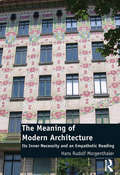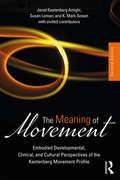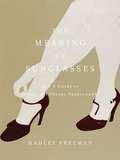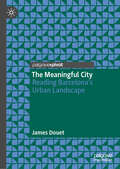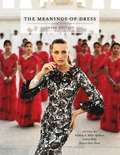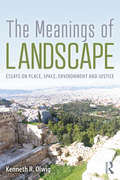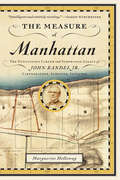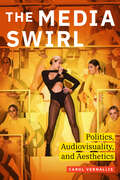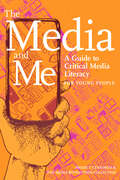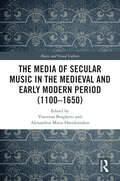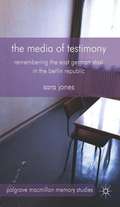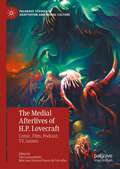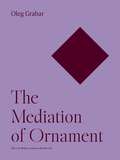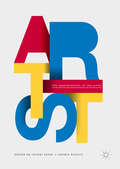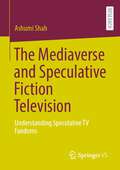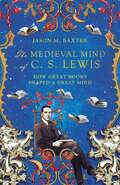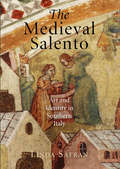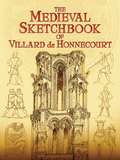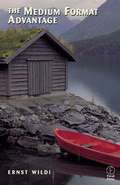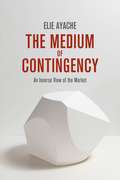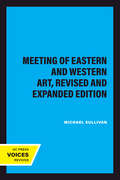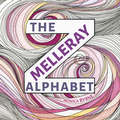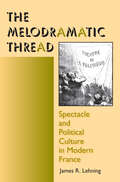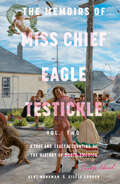- Table View
- List View
The Meaning of Modern Architecture: Its Inner Necessity and an Empathetic Reading
by Hans Rudolf MorgenthalerUsing empathy, as established by the Vienna School of Art History, complemented by insights on how the mind processes visual stimuli, as demonstrated by late 19th-century psychologists and art theorists, this book puts forward an innovative interpretative method of decoding the forms and spaces of Modern buildings. This method was first developed as scholars realized that the new abstract art appearing needed to be analysed differently than the previous figurative works. Since architecture experienced a similar development in the 1920s and 30s, this book argues that the empathetic method can also be used in architectural interpretation. While most existing scholarship tends to focus on formal and functional analysis, this book proposes that Modern architecture is too diverse to be reduced to a few common formal or ornamental features. Instead, by relying on the viewer’s innate psycho-physiological perceptive abilities, sensual and intuitive understandings of composition, form, and space are emphasized. These aspects are especially significant because Modern Architecture lacks the traditional stylistic signs. Including building analyses, it shows how, by visually reducing cubical forms and spaces to linear configurations, the exteriors and interiors of Modern buildings can be interpreted via human perceptive abilities as dynamic movement systems commensurate with the new industrial transportation age. This reveals an inner necessity these buildings express about themselves and their culture, rather than just an explanation of how they are assembled and how they should be used. The case studies highlight the contrasts between buildings designed by different architects, rather than concentrating on the few features that relate them to the zeitgeist. It analyses the buildings directly as the objects of study, not indirectly, as designs filtered through a philosophical or theoretical discourse. The book demonstrates that, with technology and science affecting culture
The Meaning of Movement: Embodied Developmental, Clinical, and Cultural Perspectives of the Kestenberg Movement Profile
by Janet Kestenberg Amighi K. Mark Sossin Susan LomanThe new edition of The Meaning of Movement serves as a guide to instruction in the Kestenberg Movement Profile (KMP) and as the system’s foremost reference book, sourcebook, and authoritative compendium. This thoroughly updated volume interweaves current developmental science, cultural perspectives, and KMP-derived theory and methods for research and techniques for clinical practice. Through the well-established KMP, clinicians and researchers in the realms of nonverbal behavior and body movement can inform and enrich their psychological interpretations of movement. Interdisciplinary specialists gain a way to study the embodiment of cognition, affects, learning styles, and interpersonal relations based on observation and analysis of basic qualities of movement.
The Meaning of Sunglasses
by Hadley FreemanEver wondered whether shorts and tights were cool or made you resemble Hamlet? If a clutch bag is classy or pointless? Have you worried for days what to wear on a date? Or simply pondered what exactly your tottery heels are saying about you? If the answer's yes to any of these questions then The Meaning of Sunglasses: A Guide to (Almost) All Things Fashionable is an essential accessory for your life, and Hadley Freeman is your new best friend.
The Meaningful City: Reading Barcelona’s Urban Landscape
by James DouetThis book presents a new way of examining cities to reveal the many and varied meanings which are written into urban landscapes. As the title suggests, urban areas are full of messages and communications, with signs and symbols incorporated into buildings, structures and plans. Taking the rich architectural and urbanistic chronicle of Barcelona as a model, the author shows how different social groups, consciously and unconsciously, have written their values and interests on to the city. The narrative opens with the forced reshaping by military engineers of the former capital of Catalunya after 1714, and extends up to an analysis of the many competing actors and agencies which attempt to impose their perspectives on the contemporary city. It scrutinizes how deep cultural and social changes such as the Enlightenment, Romanticism, the Industrial Revolution, de-industrialisation and globalisation can be read in the urban environment, as well as more intentional effects of major urban development projects including the Ciutadella fortress, the Rambles, the universal exhibitions of 1888 and 1929, the Sagrada Família, the Barcelona Model of urban renewal, the 22@ innovation district and the superil·les sustainability plans. Informed by the approach of critical urban studies, the narrative is written in a clear style to engage readers with many different interests, students, urbanists and design professionals as well as residents and visitors to the city. Drawing on research from varied academic fields published in English, Catalan and Spanish, it is illustrated with colour photographs of many of the buildings and sites that have made Barcelona a global resource for understanding contemporary cities.
The Meanings of Dress (3rd Edition)
by Kimberly A. Miller-Spillman Patricia Hunt-Hurst Andrew ReillyThis collection of articles and essays from magazines, newspapers, books, and academic journals is designed to expand the reader's awareness and understanding of the role dress plays in cultures and subcultures across the globe. The text, which represents the very best thinking and writing on the subject today, explores essential topics such as dress and sociology, cultural studies, gender, religion, modesty, and technological changes. The Meanings of Dress, 3rd Edition is newly revised to reflect the current cultural landscape and includes more theory than previous editions, as well as an increased emphasis on the male perspective. The book provides design and merchandising students with insight into how - and why - consumers buy clothing and other products related to dress, and helps them to hone their trend forecasting skills.
The Meanings of Landscape: Essays on Place, Space, Environment and Justice
by Kenneth R. OlwigCompiling eighteen authoritative essays spanning an extensive academic career, author Kenneth R. Olwig presents explorations in landscape geography and architecture from an environmental humanities perspective. With influences from art, literature, theatre staging, architecture, and garden design, landscape has come to be viewed as a form of spatial scenery, but this reading captures only a narrow representation of landscape meaning today. This book positions landscape as a concept shaped through the centuries, evolving from place to place to provide nuanced interpretations of landscape meaning. The essays are woven together to gather an international approach to understanding the past and present importance of landscape as place and polity, as designed space, as nature, and as an influential factor in the shaping of ideas in a just social and physical environment. Aimed at students, scholars, and researchers in landscape and beyond, this illustrated volume traces the idea of landscape from the ancient polis and theatre through to the present day.
The Measure of Manhattan: The Tumultuous Career and Surprising Legacy of John Randel, Jr., Cartographer, Surveyor, Inventor
by Marguerite Holloway"Randel is endlessly fascinating, and Holloway's biography tells his life with great skill."--Steve Weinberg, USA Today John Randel Jr. (1787-1865) was an eccentric and flamboyant surveyor. Renowned for his inventiveness as well as for his bombast and irascibility, Randel was central to Manhattan's development but died in financial ruin. Telling Randel's engrossing and dramatic life story for the first time, this eye-opening biography introduces an unheralded pioneer of American engineering and mapmaking. Charged with "gridding" what was then an undeveloped, hilly island, Randel recorded the contours of Manhattan down to the rocks on its shores. He was obsessed with accuracy and steeped in the values of the Enlightenment, in which math and science promised dominion over nature. The result was a series of maps, astonishing in their detail and precision, which undergird our knowledge about the island today. During his varied career Randel created surveying devices, designed an early elevated subway, and proposed a controversial alternative route for the Erie Canal--winning him admirers and enemies. The Measure of Manhattan is more than just the life of an unrecognized engineer. It is about the ways in which surveying and cartography changed the ground beneath our feet. Bringing Randel's story into the present, Holloway travels with contemporary surveyors and scientists trying to envision Manhattan as a wild island once again. Illustrated with dozens of historical images and antique maps, The Measure of Manhattan is an absorbing story of a fascinating man that captures the era when Manhattan--indeed, the entire country--still seemed new, the moment before canals and railroads helped draw a grid across the American landscape.
The Media Players
by Stephen WittekThe Media Players: Shakespeare, Middleton, Jonson, and the Idea of News builds a case for the central, formative function of Shakespeare's theater in the news culture of early modern England. In an analysis that combines historical research with recent developments in public sphere theory, Dr. Stephen Wittek argues that the unique discursive space created by commercial theater helped to foster the conceptual framework that made news possible. Dr. Wittek's analysis focuses on the years between 1590 and 1630, an era of extraordinary advances in English news culture that begins with the first instance of serialized news in England and ends with the emergence of news as a regular, permanent fixture of the marketplace. Notably, this period of expansion in news culture coincided with a correspondingly extraordinary era of theatrical production and innovation, an era that marks the beginning of commercial theater in London, and has left us with the plays of William Shakespeare, Ben Jonson, and Thomas Middleton. Book jacket.
The Media Swirl: Politics, Audiovisuality, and Aesthetics
by Carol VernallisFrom fan-generated content on TikTok to music videos, the contemporary media landscape is becoming ever more vast, spectacular, and intense. In The Media Swirl Carol Vernallis examines short-form audiovisual media—Beyoncé’s Lemonade, brief sequences from Baz Luhrmann’s The Great Gatsby, TikTok challenges, YouTube mashups, commercials, and many other examples—to offer ways of understanding digital media. She analyzes music videos by Beyoncé, Lady Gaga, Janelle Monáe, Kendrick Lamar, Anderson .Paak, and others to outline how sound and image enhance each other and shape a viewer’s mood. Responding to today’s political-media landscape through discussions of Fox News and Presidential inaugurations, Vernallis shows how a media literacy that exceeds newscasts and campaign advertising is central to engaging with the democratic commons. Forays into industry studies, neuroscience, and ethics also inform her readings. By creating our own content and knowing what corporations, the wealthy, and the government do through media, Vernallis contends, we can create a more just world.
The Media and Me: A Guide to Critical Media Literacy for Young People
by Mickey Huff Andy Lee Roth Nolan Higdon Ben Boyington Allison T. ButlerFrom foundations in critical thinking skills to practical tools and real-life perspectives, this book empowers young adult readers to be independent media users.During the recent presidential election, &“media literacy&” became a buzzword that signified the threat media manipulation posed to democratic processes. Meanwhile, statistical research has shown that 8 to 18 year-olds pack more than eleven hours with some form of media into each day by &“media multitasking.&” Young people are not only eager and interested to learn about and discuss the realities of media ownership, production, and distribution, they also deserve to understand differential power structures in how media influences our culture.The Media and Me provides readers with the tools and perspectives to be empowered and autonomous media users. The book explores critical inquiry skills to help young people form a multidimensional comprehension of what they read and watch, opportunities to see others like them making change, and insight into their own identity projects. By covering topics like storytelling, building arguments and recognizing fallacies, surveillance and digital gatekeeping, advertising and consumerism, and global social problems through a critical media literacy lens, this book will help students evolve from passive consumers of media to engaged critics and creators.The Media and Me is a joint production of The Censored Press and Triangle Square Books for Young Readers.
The Media of Secular Music in the Medieval and Early Modern Period (Music and Visual Culture)
by Vincenzo Borghetti and Alexandros Maria HatzikiriakosThis book brings a new perspective to secular music sources from the Middle Ages and early modernity by viewing them as media communication tools, whose particular features shape the meaning of their contents. Ranging from the eleventh to seventeenth centuries, and across countries and genres, the chapters offer innovative insights into the historical relationship between music and its presentation in a wide variety of media.The lens of media enables contributors to expand music history beyond notated music manuscripts and instruments to include images, furniture, luxury items, and other objects, and to address uniquely visual and material aspects of music sources in books and literature. Drawing together an international group of contributors, the volume pays close attention to the medial and material dimensions of musical sources, considering them as multifaceted objects that not only contain but also determine the nature of the music they transmit.Transforming our understanding of musical media, this volume will be of interest to scholars of musicology, art history, and medieval and early modern cultures.
The Media of Testimony
by Sara JonesThe Media of Testimony explores testimony relating to the Stasi in different cultural forms: autobiographical writing, memorial museums and documentary film. Combining theoretical models from diverse disciplines, it presents a new approach to the study of testimony, memory and mediation.
The Medial Afterlives of H.P. Lovecraft: Comic, Film, Podcast, TV, Games (Palgrave Studies in Adaptation and Visual Culture)
by Tim Lanzendörfer Max José Dreysse Passos de CarvalhoMedial Afterlives of H.P. Lovecraft brings together essays on the theory and practice of adapting H.P. Lovecraft’s fiction and the Lovecraftian. It draws on recent adaptation theory as well as broader discourses around media affordances to give an overview over the presence of Lovecraft in contemporary media as well as the importance of contemporary media in shaping what we take Lovecraft’s legacy to be. Discussing a wide array of medial forms, from film and TV to comics, podcasts, and video and board games, and bringing together an international group of scholars, the volume analyzes individual instances of adaptation as well as the larger concern of what it is possible to learn about adaptation from the example of H.P. Lovecraft, and how we construct Lovecraft and the Lovecraftian today in adaptation. Medial Afterlives of H.P. Lovecraft is focused on an academic audience, but it will nonetheless hold interest for all readers interested in Lovecraft today.
The Mediation of Ornament (The A. W. Mellon Lectures in the Fine Arts #38)
by Oleg GrabarHow ornamentation enables a direct and immediate encounter between viewers and art objectsBased on universal motifs, ornamentation occurs in many artistic traditions, though it reaches its most expressive, tangible, and unique form in the art of the Islamic world. The Mediation of Ornament shares a veteran art historian’s love for the sheer sensuality of Islamic ornamentation, but also uses this art to show how ornament serves as a consistent intermediary between viewers and artistic works from all cultures and periods. Oleg Grabar analyzes early and medieval Islamic objects, ranging from frontispieces in Yemen to tilework in the Alhambra, and compares them to Western examples, treating all pieces as testimony of the work, life, thought, and emotion experienced in one society. The Mediation of Ornament is essential reading for admirers of Islamic art and anyone interested in the ways of perceiving and understanding the arts more broadly.
The Mediatization of the Artist
by Rachel Esner Sandra KistersThis book offers trans-historical and trans-national perspectives on the image of "the artist" as a public figure in the popular discourse and imagination. Since the rise of notions of artistic autonomy and the simultaneous demise of old systems of patronage from the late eighteenth century onwards, artists have increasingly found themselves confronted with the necessity of developing a public persona. In the same period, new audiences for art discovered their fascination for the life and work of the artist. The rise of new media such as the illustrated press, photography and film meant that the needs of both parties could easily be satisfied in both words and images. Thanks to these "new" media, the artist was transformed from a simple producer of works of art into a public figure. The aim of this volume is to reflect on this transformative process, and to study the specific role of the media themselves. Which visual media were deployed, to what effect, and with what kind of audiences in mind? How did the artist, critic, photographer and filmmaker interact in the creation of these representations of the artist's image?
The Mediaverse and Speculative Fiction Television: Understanding Speculative TV Fandoms
by Ashumi ShahSome (web) television texts achieve immense commercial success. Certain commercially successful texts boast dedicated, creative, and exponentially growing fandoms. These fan communities engage in specific fan practices that are significantly influenced by the textualities of the texts and their contexts of production, distribution, and consumption. Increased fan engagement resulting in the acceleration of the text’s popularity leads to the following inquiries: · How is the series influenced by the interactions among and the relationships between the producers, consumers, distributors, and content? · What are the sites of these interactions? · What are the social, cultural, economic, and political factors that impact the series? · How do the text’s contexts of production, distribution, and consumption lead to the text’s popularity in mainstream media? In pursuit of an answer to these questions, the analytical lens of the ‘mediaverse’ is developed. An inductive study, this book explores four television series’ that fall within the scope of speculative fiction to characterise the mediaverse and highlight the interconnectedness among the networked nodes of new media. These wield a significant influence on the production and consumption of media and its presence in our everyday lives, thus outlining the mediaverse as a tool for the analysis of a media texts and practices that shape contemporary media culture.
The Medieval Mind of C. S. Lewis: How Great Books Shaped a Great Mind
by Jason M. BaxterC. S. Lewis had one of the great minds of the twentieth century.Mere ChristianityThe Problem of Pain
The Medieval Salento: Art and Identity in Southern Italy (The Middle Ages Series)
by Linda SafranLocated in the heel of the Italian boot, the Salento region was home to a diverse population between the ninth and fifteenth centuries. Inhabitants spoke Latin, Greek, and various vernaculars, and their houses of worship served sizable congregations of Jews as well as Roman-rite and Orthodox Christians. Yet the Salentines of this period laid claim to a definable local identity that transcended linguistic and religious boundaries. The evidence of their collective culture is embedded in the traces they left behind: wall paintings and inscriptions, graffiti, carved tombstone decorations, belt fittings from graves, and other artifacts reveal a wide range of religious, civic, and domestic practices that helped inhabitants construct and maintain personal, group, and regional identities.The Medieval Salento allows the reader to explore the visual and material culture of a people using a database of over three hundred texts and images, indexed by site. Linda Safran draws from art history, archaeology, anthropology, and ethnohistory to reconstruct medieval Salentine customs of naming, language, appearance, and status. She pays particular attention to Jewish and nonelite residents, whose lives in southern Italy have historically received little scholarly attention. This extraordinarily detailed visual analysis reveals how ethnic and religious identities can remain distinct even as they mingle to become a regional culture.
The Medieval Sketchbook of Villard de Honnecourt (Dover Fine Art, History Of Art Series)
by Villard De Honnecourt Theodore BowieLittle is known of Villard de Honnecourt, apart from the fact that his Sketchbook is one of the most treasured documents in art history. Active in the early part of the thirteenth century, the French artist produced remarkably accurate representations of diverse subjects that interested him: religious figures; insects, birds, dogs, and humans; architecture, including details from the cathedrals at Chartres, Rheims, and Laon; church furnishings; and mechanical devices. His technique--for the period--was fairly complex, especially when drawing the contours of draped clothing.The artist's charming, annotated sketches reveal a knowledge of architecture, sculpture, carpentry, and masonry; and his comments reflect a keen and perceptive eye, whether depicting a monumental clock tower or describing a perpetual motion machine. Comparable to da Vinci's notebooks for their historical importance, the drawings from Honnecourt's portfolio are reproduced here in their entirety, complete with authoritative translations of the artist's words, annotations, and editor's commentary.
The Medium Format Advantage
by Ernst WildiLearn the advantages and capabilities of medium-format cameras and examine all aspects of medium-format operations, including SLR, twin lens, panoramic, rangefinder, wide angle, press, and view cameras. Also explained and illustrated are lenses and their accessories, motor drives, films, flashes, filters, slides and slide projectors, and more. Includes black and white and color photographs and drawings to illustrate proper use of equipment and various techniques, effects, and possibilities that produce successful photographs with the best possible image quality. The medium format is truly the format in the middle. It combines many of the benefits of 35 mm photography with those of the large format, making a medium format system an excellent choice for almost all types of photography from candid action with a hand-held camera to critical studio work from a tripod. Special chapters are devoted to these different applications and the type of equipment that most likely meets your photography needs. This book explains clearly the medium format's benefits, advantages, and disadvantages and provides a comparison of the medium format to other formats so you can decide whether it is right for you and your photography.
The Medium of Contingency: An Inverse View of the Market
by Elie Ayache<p>In The Medium of Contingency Elie Ayache builds upon his ground-breaking book The Blank Swan, in exploring the intersection of philosophy and finance, introducing new notions of price and market. Inverting the received view, he now sees a creation of matter in both the market and its metaphysics, rather than pure speculation. <p>Once recognized as the proper medium of contingency and disassociated from the probabilistic and statistical tools traditionally used to model it, the market can be thought as 'real', in a new sense of reality corresponding to the new sense of matter. To bring this new and original perspective, The Medium of Contingency builds on probability theory as first formalized by von Mises and Kolmogorov, and later revisited by Shafer and Vovk. It utilises the author's extensive experience in derivatives pricing technology and software, as well as his work in the philosophy of contingency and contingent claims, to propose a new philosophical interpretation of Brownian motion and of the Black-Scholes-Merton formula. Then it completes the overturning of the traditional view of the market by arguing that there should be no difference, ultimately, between an underlying asset and the derivative written on it. <p>This book does not aim to change the market but the way we must think of it. It is the author's conviction that there can be no philosophy of the market, and consequently no thinking of it, without a philosophy of contingent claims and of derivative pricing. The book provides the missing piece, which the philosophy of probability cannot provide alone. Its scope, however, extends beyond the strict critique of financial mathematics, as it also, and perhaps most importantly, delivers the author's definitive treatment of the philosophically prominent and recently much discussed notion of contingency.</p>
The Meeting of Eastern and Western Art, Revised and Expanded Edition
by Michael SullivanThis title is part of UC Press's Voices Revived program, which commemorates University of California Press’s mission to seek out and cultivate the brightest minds and give them voice, reach, and impact. Drawing on a backlist dating to 1893, Voices Revived makes high-quality, peer-reviewed scholarship accessible once again using print-on-demand technology. This title was originally published in 1989.
The Melleray Alphabet
by Monica ByrneAn Illuminated Alphabet.Monica Byrne's artfully crafted alphabet gives a whimsical nod to the illuminated manuscripts of ages past. This gorgeous book will take children on an art-filled journey from A to Z. With surprising entries in three languages, children will learn to see their letters--and the world around them--in a brand new light.
The Melodramatic Thread: Spectacle and Political Culture in Modern France (Interdisciplinary Studies in History)
by James R. Lehning“This ambitious undertaking is concerned with the melodramatic form in theatre and film and its impact on French political culture.” —H-France ReviewIn France, both political culture and theatrical performances have drawn upon melodrama. This “melodramatic thread” helped weave the country’s political life as it moved from monarchy to democracy. By examining the relationship between public ceremonies and theatrical performance, James R. Lehning sheds light on democratization in modern France. He explores the extent to which the dramatic forms were present in the public performance of political power. By concentrating on the Republic and the Revolution and on theatrical performance, Lehning affirms the importance of examining the performative aspects of French political culture for understanding the political differences that have marked France in the years since 1789.“In this thoroughly researched and persuasive book, Lehning provides a fascinating reading of public performances in modern France . . . This is an important contribution to the study of French culture and the democratization process . . . Essential.” —Choice“Lehning’s application of the themes of melodrama to French political culture offers new insights into French history. His style is lively, clear, and highly readable.” —Venita Datta, Wellesley College“The analyses in this book make a real contribution to debates about the ways in which art, particularly popular art, and politics interact; how politics itself is theatrical in the French case; and the role of ritual in politics and the function of politics as ritual and ceremony.” —John Gaffney, Aston University
The Memoirs of Miss Chief Eagle Testickle: A True and Exact Accounting of the History of Turtle Island
by Kent Monkman Gisèle GordonFrom global art superstar Kent Monkman and his longtime collaborator Gisèle Gordon, a transformational work of true stories and imagined history that will remake readers' understanding of the land called North America.For decades, the singular and provocative paintings by Cree artist Kent Monkman have featured a recurring character—an alter ego of sorts, a shape-shifting, time-travelling elemental being named Miss Chief Eagle Testickle. Though we have glimpsed her across the years, and on countless canvases, it is finally time to hear her story, in her own words. And, in doing so, to hear the whole history of Turtle Island anew. The Memoirs of Miss Chief Eagle Testickle: A True and Exact Accounting of the History of Turtle Island is a genre-demolishing work of genius, the imagined history of a legendary figure through which a profound truths emerge—a deeply Cree and gloriously queer understanding of our shared world, its past, its present, and its possibilities.Volume Two, which takes us from the moment of confederation to the present day, is a heartbreaking and intimate examination of the tragedies of the nineteenth and twentieth century. Zeroing in on the story of one family told across generations, Miss Chief bears witness to the genocidal forces and structures that dispossessed and attempted to erase Indigenous peoples. Featuring many figures pulled from history as well as new individuals created for this story, Volume Two explores the legacy of colonial violence in the children&’s work camps (called residential schools by some), the Sixties Scoop, and the urban disconnection of contemporary life. Ultimately, it is a story of resilience and reconnection, and charts the beginnings of an Indigenous future that is deeply rooted in an experience of Indigenous history—a perspective Miss Chief, a millennia-old legendary being, can offer like none other. Blending history, fiction, and memoir in bold new ways, The Memoirs of Miss Chief Eagle Testickle are unlike anything published before. And in their power to reshape our shared understanding, they promise to change the way we see everything that lies ahead.
